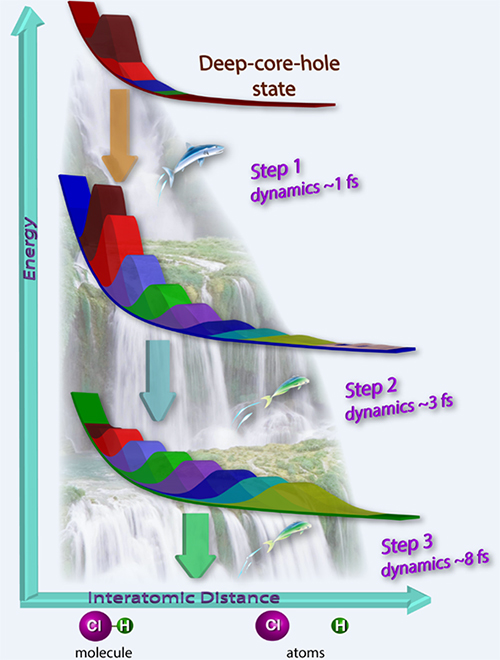Interaction of light with matter is multifarious. Light can be absorbed, emitted, reflected, scattered. It can warm and cool, destroy or heal. Light, or electromagnetic radiation, of various specific characteristics, is often used in research to get insights into the laws of nature, e.g. properties of matter, its structure, formation or degradation. The energy carried by the absorbed light may lead to matter ionization or its transfer to unstable transient excited states, which would then relax, releasing the excess energy (all at once or by portions in several steps) in many forms, e. g. emission of photons and/or electrons, which is often accompanied by structural deformations, such as changes in bond lengths, twisting and rotation of bond angles, isomerization or even bond breakages.
Usually, structural deformations are rather slow and take place on considerably longer time scales compared to the emission of electrons or photons. However, when using, e.g., soft x-ray radiation, highly excited states can be reached with very strong dissociative character and nuclear movement can become competitive to the electronic decay. Soft x-ray radiation reaches typically electrons in shallow core shells, which are then ionized or promoted to unoccupied valence shells. Corresponding core-hole states lifetimes are in the range of a few femtoseconds (1 fs = 10-15 s), which can be sufficient for the light nuclei (H, O - atoms, OH-, CH3-, NH2– atomic groups) to move far enough from the rest of the molecule to lead to the complete breakage of the chemical bond. More energetic hard x-rays may reach electrons lying in deeper core shells. The lifetime of the deep-core-hole states is on the order of only 1 femtosecond or even below. Nuclear dynamics occurring in these deep-core-hole states is very weak and by far insufficient to lead to dissociation.
A group of researchers from Laboratoire de Chimie Physique - Matière et Rayonnement in France (CNRS/UPMC), Freie University in Germany, Uppsala University in Sweden, UVSOR facility in Japan and synchrotron SOLEIL in France showed that the deep-core-hole creation induced by hard x-rays may also lead to extensive nuclear dynamics and bond breakage on a few femtosecond time scale (~10 fs), which occurs not in the deep-core-hole state itself but in the following cascade of the relaxation decays. Moreover, the dynamics occurring in the initially created deep-core-excited state, though not extensive, is crucial for the overall fragmentation outcome as the atoms get thrust to move apart, thus gaining velocity, which increases the dissociation rate in the following cascade steps. A dissociative deep-core-hole state with the lifetime of ≤1 fs is impetus to create the domino effect of the bond elongation in the following cascades leading to abundant dissociation on a femtosecond time scale.

Figure: Illustration of the cascade relaxation decay of the deep-core-excited (Cl 1s->sigma*) state of HCl, produced by hard x-ray absorption. Potential energy curves for the initially created deep-core-hole state as well as for the intermediate states are highly dissociative. H-Cl bond elongation occurs at every step of the cascade decay process leading to ultrafast fragmentation on a few femtosecond timescale. In the figure, the energy is released by portions at every transition by emitting an electron (depicted by fish in the schematics), therefore the charge of the subsequent intermediate states increases in the course of the cascade. The coloured peaks on the potentials represent populations of the states, where each colour corresponds to the time elapsed after absorption of a hard x-ray photon from 1 to 8 fs with 1 fs increments.
The experimental work has been performed on isolated HCl molecules using hard x-ray photoelectron spectroscopy setup at the GALAXIES beamline of the SOLEIL synchrotron. This is a unique place nowadays, where these gas phase measurements can be done, as it combines high brilliance of the hard x-ray light source and high-resolution electron spectrometer equipped with the gas cell, which are required. The experimental observations are supported by theory in collaboration with the groups from Oulu University (Finland) and LCPMR, Paris (France).
The discovered phenomenon – called MUST UFD (MUltiSTep UltraFast Dissociation) – is predicted to be rather general. Notably, double-core-hole states and multiply charged single-core-hole states are generally produced in the course of the cascades. Those can be even more dissociative than neutral excited single-core-hole states. Significant displacement of nuclei from their equilibrium geometry within a few femtosecond time scale can be thus expected to accompany hard x-ray absorption by molecules, containing elements of the third period or below, which are bound to light atoms or light linkages. These results might be of great importance for radiation biology and could have direct implications in the interpretation of single-shot X-ray imaging of bio-objects.
